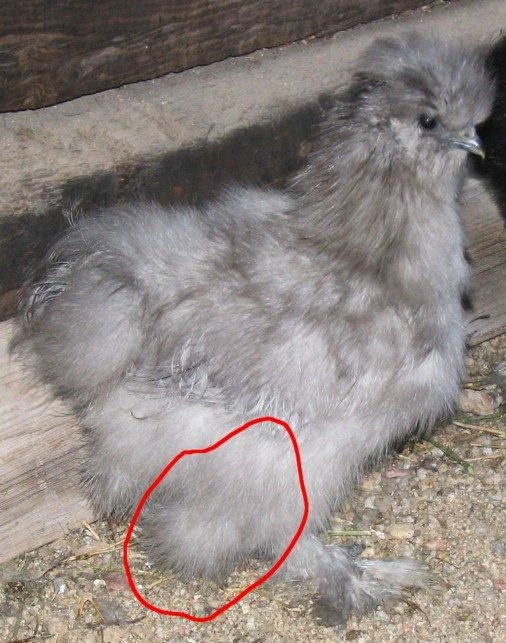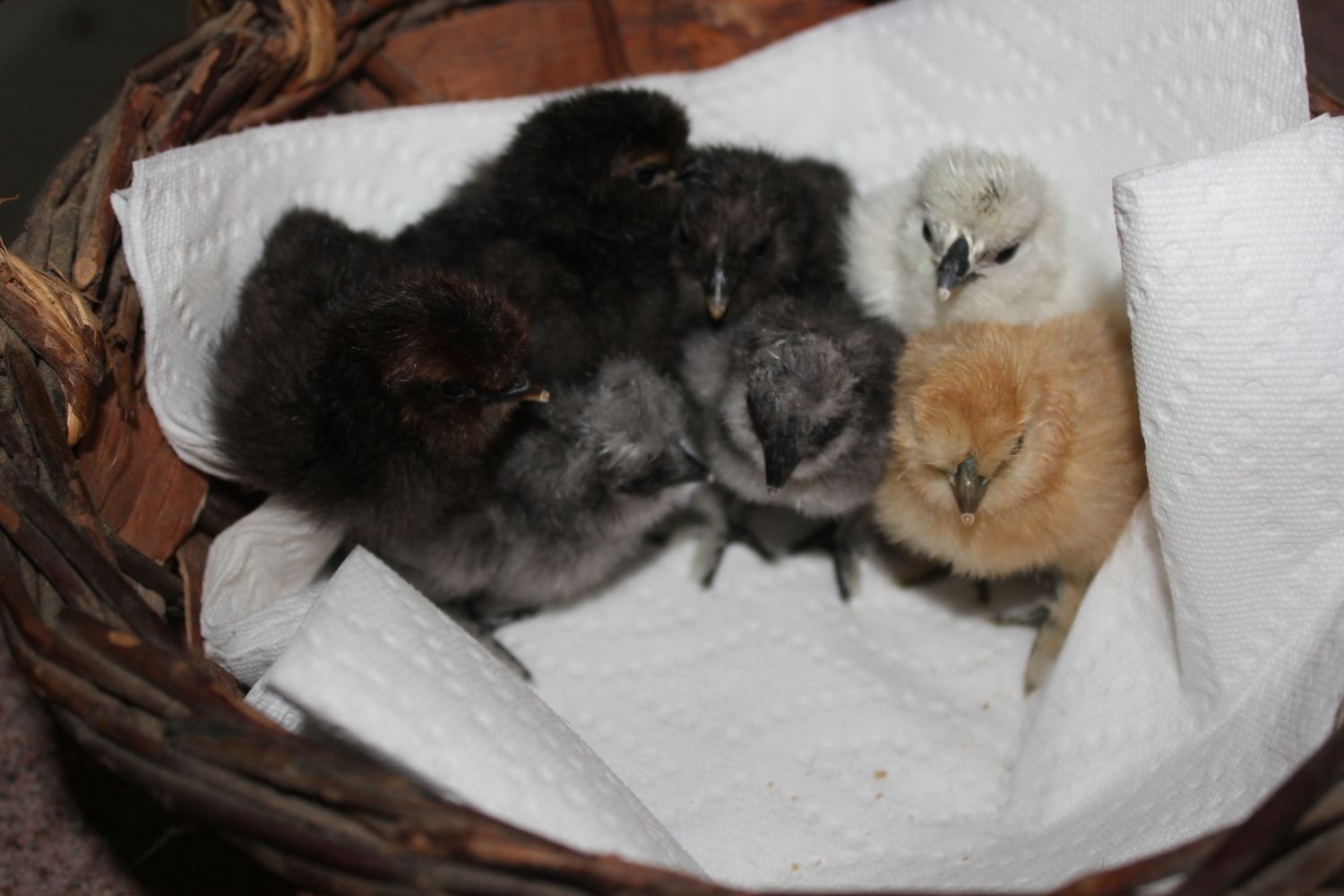What is the best way for me to safely ID tiny chicks of the same color?
Navigation
Install the app
How to install the app on iOS
Follow along with the video below to see how to install our site as a web app on your home screen.
Note: This feature may not be available in some browsers.
More options
You are using an out of date browser. It may not display this or other websites correctly.
You should upgrade or use an alternative browser.
You should upgrade or use an alternative browser.
Silkie thread!
- Thread starter americana-chick
- Start date
- May 4, 2012
- 1,485
- 36
- 148
I sold this chick as a pet because I thought it was developing vulture hocks. A lack of feathering on the leg creates a large bunching of feathers on the hock. I now believe I was a bit premature to make that decision. Not the best photo to describe the problem or the best explanation but hopefully you get some idea.What are vulture hocks? I was reading that it was a trait that is undesirable trait. Does anyone have pics?

Oh, okay. I see now. This type of feathering is on my cochin and d'uccle, I didn't realize that is what it was. Thanks for the pic, very helpful.I sold this chick as a pet because I thought it was developing vulture hocks. A lack of feathering on the leg creates a large bunching of feathers on the hock. I now believe I was a bit premature to make that decision. Not the best photo to describe the problem or the best explanation but hopefully you get some idea.

In silkies it is a DQ.Oh, okay. I see now. This type of feathering is on my cochin and d'uccle, I didn't realize that is what it was. Thanks for the pic, very helpful.
Multi colored zip ties. I buy the really small ones. I will even double band -- like 2 yellows on a leg when I run out of colors.What is the best way for me to safely ID tiny chicks of the same color?
 Just make sure you put them on good and loose and check often to clip them off before they get too small. I just clip off and put new ones on until they are ready to be banded. The easiest way to get them on is to go ahead and put the end thru and make a large loop and then put the foot through and then pull it tighter. Even at that, I leave it so loose that the only thing keeping it on is the splayed out toes. That way there is plenty of room to grow in case I accidentally leave one on too long. Which I've never done, but it does worry me enough to be cautious. Just don't make it so loose that when they pick up their foot, it will slide off.
Just make sure you put them on good and loose and check often to clip them off before they get too small. I just clip off and put new ones on until they are ready to be banded. The easiest way to get them on is to go ahead and put the end thru and make a large loop and then put the foot through and then pull it tighter. Even at that, I leave it so loose that the only thing keeping it on is the splayed out toes. That way there is plenty of room to grow in case I accidentally leave one on too long. Which I've never done, but it does worry me enough to be cautious. Just don't make it so loose that when they pick up their foot, it will slide off.Ok, this has been addressed before. In Silkies, the feathering is soft, so the feathers aren't technically "vulture hocks". As a vulture hock is a group of hard feathers pointing downward, as in a D'uccle. At this age of bird, they all seem to have some sort of feathering like this, at least here, and it seems more in the roos, but it incorporates into their adult plumage. I believe Sonoran was the one that answered that question for me over a year or so ago? Maybe she can explain again?I sold this chick as a pet because I thought it was developing vulture hocks. A lack of feathering on the leg creates a large bunching of feathers on the hock. I now believe I was a bit premature to make that decision. Not the best photo to describe the problem or the best explanation but hopefully you get some idea.

I don't know how anyone who is hatching gets any sleep at hatch time.
It's not even 3am and I woke up and couldn't go back to sleep so I had to come down to check on the babies hatching.
Another silkie is out, that makes 2. 2 more are working on it, so hopefully later today.
I have 12 in lockdown but I don't think my hatch rate is going to be any higher than 30%.
They were shipped eggs so I am not expecting a lot.
I think if I have at least one silkie that is broody next spring, I will go pick up some Catdance eggs and try that. No more shipped eggs if I can help it.
Or if I am really lucky and have a pair that I can breed, I will hatch out my own.

It's not even 3am and I woke up and couldn't go back to sleep so I had to come down to check on the babies hatching.
Another silkie is out, that makes 2. 2 more are working on it, so hopefully later today.
I have 12 in lockdown but I don't think my hatch rate is going to be any higher than 30%.
They were shipped eggs so I am not expecting a lot.
I think if I have at least one silkie that is broody next spring, I will go pick up some Catdance eggs and try that. No more shipped eggs if I can help it.
Or if I am really lucky and have a pair that I can breed, I will hatch out my own.

I wish I knew, lol! All three of the homegrown ones had the same parents. It was a black roo over a buff hen. I had no intention of breeding them, but since I was firing up the incubator... lol.What color are those dark red chicks?
Multi colored zip ties. I buy the really small ones. I will even double band -- like 2 yellows on a leg when I run out of colors.Just make sure you put them on good and loose and check often to clip them off before they get too small. I just clip off and put new ones on until they are ready to be banded. The easiest way to get them on is to go ahead and put the end thru and make a large loop and then put the foot through and then pull it tighter. Even at that, I leave it so loose that the only thing keeping it on is the splayed out toes. That way there is plenty of room to grow in case I accidentally leave one on too long. Which I've never done, but it does worry me enough to be cautious. Just don't make it so loose that when they pick up their foot, it will slide off.
x2 and I got this idea from Jessy: I put a green zip on the ones I know can be sold.
New posts New threads Active threads
-
Latest threads
-
Open Contest BYC Poultry Caption Contest 12-26-25 Pic by thecatumbrella
- Started by TwoCrows
- Replies: 5
-
Open Contest BYC Pets & Livestock Caption Contest 12-26-25 Pic by chickengirls16
- Started by TwoCrows
- Replies: 3
-
Looking for a cause of death for my hen
- Started by diprilif
- Replies: 1
-
-
Lethargic chicken with diarrhea and firm abdomen.
- Started by superjec
- Replies: 0
-
-
Threads with more replies in the last 15 days
-
Heater or heat panel -10
- Started by IowaCHKN
- Replies: 156
-
-
Introducing TUDYBOOK - The Tudy Coloring Book Generator
- Started by Nifty-Chicken
- Replies: 57
-
-
Ended BYC Pets & Livestock Caption Contest 12-12-25 Pic by Gill-b
- Started by TwoCrows
- Replies: 45
-
×


